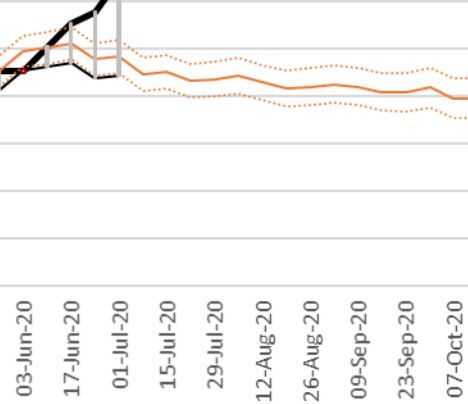Quoted verbatim, this is the claim made about excess deaths: "In the period, 6 May - 7 July 2020, there has been an excess of 10,994 deaths from natural causes of persons 1+ year old when using a revised base accounting for lower mortality during lockdown."
This figure of 10,994 is remarkable when compared to the reported Covid-19 deaths for the same period, amounting to 3,354. (Cumulative reported Covid-19 deaths numbered 3,502 on 7 July, less the cumulative reported Covid-19 deaths of 148 on 5 May).
It might be tempting to conclude that approximately 30% of the true Covid-19 deaths are actually being reported and we may be significantly understating the true Covid-19 deaths. If that were true, it would of course go some way to explaining the chasm between the experienced reality and the government's "Epi-model", as argued during the [Western Cape modelling presentation on 29 June].
The data that is being used in this report comes from the population register, which is maintained by Home Affairs. When someone dies in South Africa, the family of the deceased must report the death at Home Affairs, a Police Station or a recognised undertaker who then transmits that data to Home Affairs. This means that in order for a death to be recorded, people need to be able to move around, and the places they need to visit to report the death, as well as Home Affairs, need to be open for business. This is patently hindered by lockdown.
Excess deaths are essentially the difference between expected deaths and actual reported deaths. We should be comparing deaths from natural causes only, since we know that the hard lockdown we experienced had a reducing effect on the number of deaths from accidental causes.
There are two problems with how the SAMRC have calculated excess deaths here though.
(1) In their own words, for the actual number of deaths, "These have been scaled up to estimate the actual number of deaths by accounting for the people who are not on the population register and the under-registration of deaths."
(2) The expected number of deaths for the period is opaque at best. Insufficient information is presented as to how these estimates are derived..
The Actual Reported Deaths
The SAMRC does not elaborate on the method they used for scaling up the actual number of deaths. This raises the following questions:
- What were the actual deaths before the adjustment?
- Does SAMRC always make an adjustment like this in reporting actual deaths?
- Does SAMRC normally adjust the expected deaths to also take into account people who are not on the population register?
- At what point in time does SAMRC make adjustments for the "under-registration"? There must surely be a known lag that can be accounted for?
The Expected Deaths
This is where the numbers get concerning, since what the SAMRC have done is to use the lower bound of the estimated death range in determining the expected deaths. You might assume that SAMRC calculates the expected deaths using the last five to ten years of data. Not so, probably because the legacy of the government's poor response to HIV results in a high baseline. Instead, for this report, SAMRC used 2017 and 2018 data only.
Their calculation is best illustrated with their published graph.
If you zoom in on the relevant section, you can see the thin black line is labelled as their "Base". This is the lowest number of deaths SAMRC was expecting over the period. In other words, rather than expecting the average number of deaths over this period, SAMRC have used the lowest baseline they could find to calculate the excess deaths. At first blush the logic for this assertion seems difficult to fathom.
The SAMRC are not silent on this adjustment. Essentially what they say in the following verbose rationalisation is that because natural deaths were down during lockdown, they ignored that data and reset the baseline for the excess deaths calculation from the point where there was a rapid increase in those deaths:
"During lockdown in South Africa, it was observed that the number of natural deaths was much lower than predicted value than in other countries and the weekly numbers were tracking the predicted trend at a level between the lower prediction bound and the predicted value. Using the predicted value as the base would understate the impact of the COVID-19 epidemic. It was therefore decided to identify the relative level that the deaths were tracking during the lockdown, prior to the emergence of the COVID-19 deaths. The estimated number of deaths in the week prior to a clear rapid increase in numbers (e.g. the week starting on 6 May for Cape Town, Western Cape and nationally) was taken as a proportion of the lower prediction bound and the base was calculated to track the lower bound. The proportion was set to produce the numbers of reported COVID-19 deaths in that week. The estimated numbers of excess natural deaths are reported in Table 1, calculated in excess of the revised base to account for the mortality drop experienced during lockdown."Before we dig into this statement, it is worth observing how the actual deaths were tracking the expected deaths prior to Covid-19 (and lockdown) taking off in South Africa.
As you can see, the actual deaths were tracking between the best estimate line and the upper bound for the first quarter - and comparing the two shows that actual deaths were actually 2.45% higher than the expected deaths during this period. Nevertheless, this indicates that the best estimate was performing fairly well in the pre-COVID period.
The SAMRC offer no hypothesis for why natural deaths (these figures exclude non-natural deaths like road accidents and murders) would fall to the lower bound the moment the lockdown started. Such an immediate effect would be surprising, as the reduced infections they are presumably attributing this to would have only result in lower deaths much later. The leading causes of deaths from natural causes in South Africa are HIV/AIDS, cardiovascular disease, respiratory diseases (e.g. TB) and diabetes.
It does not make any sense that deaths from natural causes should have reduced during lockdown, especially since the natural deaths were tracking at or above the best estimate of natural deaths immediately prior to lockdown. If anything lockdown would have exacerbated natural cause deaths since access to medical care had been so severely constrained, and evidence from other parts of the world is starting to mount that this is in fact the case.
What does make sense is that lockdown made it more difficult to report deaths and made it more difficult for Home Affairs to record them. It does make sense that when the lockdown was relaxed, people were able to report and record those deaths, Home Affairs got back up to steam and the deaths that had occurred during lockdown started coming through, causing the actual deaths line to shoot through the best estimate line from around Mid-June. For this calculation to be useful, the figures should be smoothed to account for these systemic failures, with deaths appearing to occur in June being allocated to May. Unfortunately only SAMRC has access to the raw population data, so we can only estimate such an adjustment.
If we make the assumption that the best estimate of natural deaths was indeed an accurate reflection of base mortality, and the experience of the first quarter of 2020 suggests that this assumption may actually still be conservative, the following two implications emerge:
- Looking at excess deaths as reported for a single week since lockdown level 3 is not useful, particularly since we should expect the unrecorded deaths from the hard lockdown period to start coming through as lockdown was relaxed.
- The generally accepted method for calculating overall excess deaths is to measure the actual deaths against the best estimate (the average) of the expected deaths. Deviation from this method requires a more detailed explanation from SAMRC. Restating the results, if we compare the actual deaths to the original best estimate of deaths, we calculate an excess of 3,159 deaths. This is far closer to the reported COVID-19 deaths for that period of 3,354. That suggests that there are very few COVID-19 deaths being missed currently. This is an entirely different conclusion to the implied result that only 30% of COVID-19 deaths are being accurately recorded right now. An example of how easy it is to manipulate this data.
In the first quarter of 2020 (Weekly data from 1 January to 25 March), deaths from natural causes alone ran at 2.45% higher than the best estimate (actual of 100,988 compared to expected of 98,573).
Just as SAMRC rebases their calculation arbitrarily, it is entirely logical to assume THIS is the real best estimate going into the second quarter and beyond. We are acutely aware that this is falsifiable, but present it as an example of manipulation towards an end. To persist with this reasoning, this was the normal experience immediately before Covid-19 emerged in South Africa - 2.45% higher than normal.
Therefore, we could inflate the best estimate of natural deaths during the new reporting period by 2.45% to get a "true" best estimate which comes to 103,005 deaths expected. The actual estimated natural deaths during that reporting period came to 102,829.
Subtracting the difference would then show that there were in fact no excess deaths, and remarkably there were 176 fewer deaths than expected.
Further remarks
The report also raises the following questions:
- What would the motivation be to inflate the number of excess deaths? Only last week, Cyril Ramaphosa was still justifying lockdown on the basis that there will be up to 50,000 deaths in South Africa. The model that figure is based on has now been shown to be massively divorced from reality because far fewer actual deaths have occurred than the model predicts. Increasing the actual deaths by saying that the official figure falls short would be a way to explain the shortfalls in the model. Astute readers will have noted a connection between one of the contributors to the SAMRC report and the coordinator of the South African Covid-19 Modelling Consortium.
- It is reasonable and expected that lockdown itself, and avoidance of hospital visits would result in additional non-COVID natural deaths. These would emerge with some lag and could persist for a number of years. Therefore, one should be very careful to make the leap to attribute all excess deaths to COVID. Many of these deaths may inadvertently have been caused by the lockdown.
- It is not clear why the SAMRC adjusted the baseline for Johannesburg based on the expected (average) line whereas Cape Town's baseline is based on the lower bound and Buffalo City is below the lower bound.
- The upper and lower bounds quite reasonably allow for random variation, and the shape allows for seasonality. (e.g. the flu season in winter). Are the grounds to change the definition reasonable and rational?
It is possibly even stranger that the report makes no mention of a commonly experienced problem elsewhere. Owing to COVID-19 being a notifiable disease, even deaths of people from other causes that don't involve the presentation of any clinical COVID-19 symptoms, are counted as COVID-19 deaths. It is a significant omission to make no adjustment for these, as they have been shown to be material in other countries where this is the reporting approach.








Reader Comments
to our Newsletter